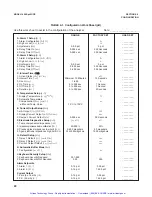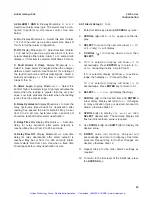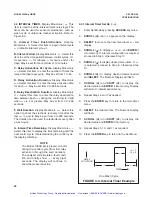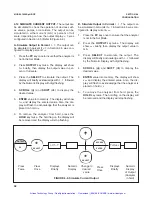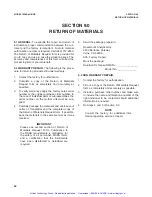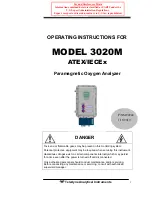
34
MODEL 1054B pH/ORP
SECTION 5.0
START-UP AND CALIBRATION
5.3.2 Calibration With Automatic Features
Disabled.
1.
Press the
HOLD
key twice to place the analyzer
in hold.
2.
Obtain two pH buffer solutions with values at
least two pH units apart. Unopened buffers have
a shelf life of about a year and once opened they
should generally not be reused because of possi-
ble contamination.
3.
Shake the sensor down to remove entrapped air
bubbles from the pH glass electrode tip.
4.
Place the sensing portion of the pH sensor into a
beaker containing the first buffer solution.
5.
Allow the pH reading to stabilize. Allow the pH
reading to stabilize. This may take several min-
utes, as the pH sensor may need to cool down to
the buffer temperature. If you don't wait long
enough you may get a slope error. Then note the
temperature and find the buffer value at that tem-
perature. Buffer values at various temperatures
are located on the label of most buffer bottles.
6.
Press the
CAL
key once.
bF1
will display briefly,
followed by the Numeric Display with digit flash-
ing. If
bF2
displays, press the
CAL
key again.
7.
SCROLL
(
é
) and
SHIFT
(
ç
) to key in the buffer
solution value, then
ENTER
it into memory.
8.
Remove the sensor from the buffer, rinse and dry it.
9.
Place the sensing portion of the pH sensor into a
beaker containing the second buffer solution.
10. Allow the pH reading to stabilize. See note in step
5.
11. Press the
CAL
key once.
bF2
will display briefly,
followed by the Numeric Display with digit flash-
ing. If
bF1
displays, press the
CAL
key again.
12.
SCROLL
(
é
) and
SHIFT
(
ç
) to key in the buffer
solution value, then
ENTER
it into memory.
13. Press the
HOLD
key twice to remove the analyz-
er from hold.
14. For maximum accuracy, perform a process stan-
dardization after a buffer calibration (see Section
5.4). Also, you can track your electrode slope
value after a buffer calibration to see how the
electrode is aging (see Section 5.5).
5.4 pH STANDARDIZATION (1054B pH only).
For
maximum accuracy, the sensor should be standard-
ized on-line or in a process grab sample after a buffer
calibration to account for the sensor junction potential.
Sensor standardization will not calculate the sensor’s
slope.
1.
Take a grab sample which is as close to the sen-
sor as possible. Write down the value the analy-
zer is reading at this time.
2.
Using a calibrated pH instrument with automatic
temperature compensation, determine the pH of
the process or grab sample. The calibration is
best performed at the process temperature. Write
down this value. (If the sample pH is greater than
about 6.5 and the lab sample is run at a substan-
tially different temperature than the process, see
Section 4.7).
3.
Before entering the standardized value, compare
the value the analyzer is reading now to the value
in Step 1. Add this change to the reference value
obtained in Step 2. This accounts for the change
while the grab sample is being measured.
4.
Press the
pH
key once, then press the
SELECT
key.
Std
will show followed by the Numeric
Display with digit flashing.
5.
SCROLL
(
é
) and
SHIFT
(
ç
) to key in the cor-
rected reference pH value determined in Step 3
then
ENTER
it into memory.
5.5 pH GLASS SLOPE.
The slope/efficiency of the
glass electrode can be displayed or entered directly (if
known) without buffer calibrating (A new electrode has
a slope of about 59 mV/pH. As electrode ages the
slope will decrease to about 47-49 mV/pH).
1.
Press the
CAL
key twice, then the
SELECT
key
once.
2.
SCROLL
(
é
) and
SHIFT
(
ç
) to key in the correct
value then
ENTER
it into memory.
5.6 SENSOR MAINTENANCE.
Before performing
buffer checks or maintenance of the sensor, the ana-
lyzer should be placed in hold. This will place the cur-
rent output and relays in the state set in the default
setup (Section 4-8). Press the
HOLD
key twice. The
hold flag will show to indicate the hold condition.
Always calibrate after cleaning or repair of the pH sen-
sor. (Refer to Sections 5.1.2 and 5.1.3.) After installing
the sensor back in the process, press the
HOLD
key
twice again to remove the analyzer from hold.
NOTE
To clean the electrode, rinse with distilled
water or diluted acid/base, then gently dry
with a clean tissue. The electrode should
not be rubbed or abraded because this
increases the electrostatic forces and thus
the response time of the electrode, and it
also rapidly ages the delicate electrode gel
layer. If possible, increase the stirring or
flow velocity past the electrode rather than
rubbing or brushing it.
For any additional instructions, please refer
to the appropriate sensor instruction manu-
al.
Artisan Technology Group - Quality Instrumentation ... Guaranteed | (888) 88-SOURCE | www.artisantg.com

